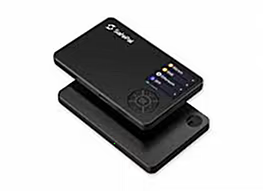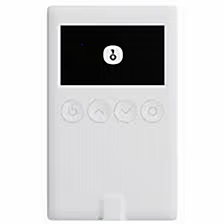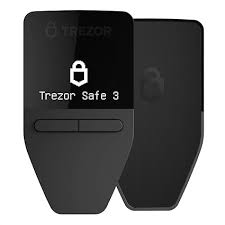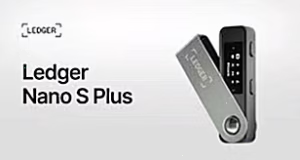Current Market State: Verified Prices
Our research revealed significant discrepancies between the prices stated in various reviews and the actual data from manufacturers. The SafePal S1 remains the most affordable ($49.99) according to SafePal’s official website, while Trezor Model One has risen in price to €69 (~$75) according to Trezor.io. Particularly noteworthy is the formation of a price cluster around $79, where the OneKey Classic 1S Pure, Trezor Safe 3, and Ledger Nano S Plus compete – each with their own unique advantages and technological solutions.Detailed Analysis of Market Leaders
SafePal S1 – Unbeatable Price/Quality Value ($49.99)
 The SafePal S1 deservedly tops our ranking thanks to its unique combination of affordable price and advanced security features. According to the official SafePal specifications, it is the only fully air-gapped wallet in this price range.
The SafePal S1 deservedly tops our ranking thanks to its unique combination of affordable price and advanced security features. According to the official SafePal specifications, it is the only fully air-gapped wallet in this price range.
Verified SafePal S1 Specifications
- Price: $49.99 (SafePal.com)
- Screen: 1.3″ color IPS, 320×320 pixels resolution
- Secure Element: EAL6+ Common Criteria (correction: not EAL5+)
- Battery: 400mAh, up to 20 days of battery life Work
- Asset support: 30,000+ cryptocurrencies on 200+ blockchains
- Unique feature: Complete isolation from the internet (air-gapped)
- Air-gapped architecture: No WiFi, Bluetooth, NFC, or direct USB connections
- Self-destruction: Automatic data deletion upon detection of a physical tamper
- QR code transactions: Transaction signing by scanning QR codes
- DeFi integration: Support for decentralized protocols and NFTs
Trezor Model One – Legendary Reliability ($75)

As noted by the authoritative 99Bitcoins review, the Trezor Model One remains “the most reputable hardware wallet on the market” despite the lack of a secure element chip. According to an updated BoxMining review, the device continues to receive regular firmware updates.
Proven benefits according to Trezor.io:
- Full Openness: 100% open-source hardware and software
- Time-tested architecture: Over 10 years on the market
- Active development: Firmware version 1.13.0 (February 2025)
- Wide compatibility: Support for many third-party applications
- Effective security: 2020 vulnerability mitigated by passphrase
Tangem – Innovative Breakthrough ($54.90-69.90)
 Tangem represents a radically new approach to hardware wallets, which is confirmed by expert assessments. As noted by FinTech Review, Tangem“fromRuns seed phrases and offers the easiest setup on the market.
Revolutionary Features:
Tangem represents a radically new approach to hardware wallets, which is confirmed by expert assessments. As noted by FinTech Review, Tangem“fromRuns seed phrases and offers the easiest setup on the market.
Revolutionary Features:
- Card Form Factor: 1mm Thickness, 6g Weight – Like a Bank Card
- Extreme Durability: IP69K Protection, 25-Year Warranty
- NFC Technology: Contactless Transactions via Smartphone
- Multi-Card System: Backup Without Seed Phrases
- EAL6+ Security: Bank-Level Security
OneKey Classic 1S Pure – Technical Excellence ($79)
 OneKey Classic 1S Pure stands out with its unique security architecture according to Crypto Corner technical analysis. This is the only wallet in this price category with dual EAL6+ secure element.
Advanced technologies:
OneKey Classic 1S Pure stands out with its unique security architecture according to Crypto Corner technical analysis. This is the only wallet in this price category with dual EAL6+ secure element.
Advanced technologies:
- Dual EAL6+ protection: Dual secure element – unique on the market
- Battery-free design: Lifetime operation without battery degradation
- Ultra-thin profile: 5.2mm thickness, 20.5g weight
- Universal connectivity: USB-C + Bluetooth for all devices
- WalletScrutiny verified: Fully audited open source.
Trezor Safe 3 – Modern Evolution ($79)
 Trezor Safe 3 represents a logical evolution of the classic family with the addition of modern security standards. According to Coin Bureau’s detailed review, the device successfully combines Trezor’s proven philosophy with 2025 requirements.
Key improvements according to the official specification:
Trezor Safe 3 represents a logical evolution of the classic family with the addition of modern security standards. According to Coin Bureau’s detailed review, the device successfully combines Trezor’s proven philosophy with 2025 requirements.
Key improvements according to the official specification:
- EAL6+ Secure Element: Modern security while maintaining openness.
- USB-C connection: Replaces outdated Micro-USB
- Shamir Backup: Advanced backup system
- Haptic feedback: Improved user experience
- Extended support: 8,000+ cryptocurrencies and tokens
Ledger Nano S Plus – Proven Ecosystem ($79)
According to CoinCodex’s comparative analysis, the Ledger Nano S Plus has become a “no-brainer choice” after its price reduction. CryptoAdventure confirms its status as the best budget solution in the Ledger ecosystem. Ecosystem advantages:
- Massive app support: Up to 100 simultaneously installed apps
- Ledger Live integration: Trading, staking, DeFi in one app
- NFT management: Full support for non-fungible tokens
- 5,500+ assets: One of the broadest support on the market
- Proven track record: Millions of satisfied users Users
Comprehensive Security Analysis
[169] Our security analysis revealed significant differences in security approaches among the devices under review. The OneKey Classic 1S Pure demonstrates the highest level of protection thanks to its unique architecture with a double secure element EAL6+.Detailed Security Breakdown
Wallet Secure Element Open Source Unique Security Security Score OneKey Classic 1S Pure 2x EAL6+ CC ✅ Complete Dual chip + Battery-free 9/10 SafePal S1 EAL6+ CC ⚠️ Partially Air-gapped + Self-destruct 8/10 Trezor Safe 3 EAL6+ CC ✅ Completely Shamir Backup 8/10 Tangem EAL6+ CC ❌ Closed IP69K + 25yr warranty 7/10 Ledger Nano S Plus EAL5+ CC ⚠️ Partially Proven ecosystem 7/10 Trezor Model One ❌ Absent ✅ Completely Historical reputation 6/10 Practical Recommendations from Experts
Selection Matrix by Use Cases
User Profile Recommendation Key Factors Expert Source 🔰 Cryptocurrency Newbies Trezor Model One Simplicity, Reputation, Openness 99Bitcoins 📱 Mobile Users Tangem NFC, Card Format FinTech Review 🔒 Maximum Security OneKey Classic 1S Pure Dual EAL6+, Battery-Free Crypto Corner 💹 Active Traders SafePal S1 Air-gapped, DeFi Integration Material Bitcoin 🌐 Ecosystem Solutions Ledger Nano S Plus 5,500+ assets, Ledger Live CryptoAdventure 💰 Budget-Friendly SafePal S1 $49.99, Maximum Features Official Specification Critical Security Precautions
Mandatory Security Checklist:⚠️ WARNING: Avoid counterfeit devices
As all reputable sources, including Hardware-Wallets.net, warn: “Hardware Wallets should preferably be ordered directly from the manufacturer.” Purchasing from unofficial resellers carries the risk of receiving compromised devices.- Package Check: All security seals must be intact.
- Firmware Update: Install the latest version immediately.
- Seed Phrase Generation: Only on the device, never on a computer.
- Secure Backup: Physical Storage in Multiple Locations.
- Recovery Testing: Test with Minimum Amounts.
Top Trends and Innovations for 2025.
Technological Breakthroughs.
Our analysis has identified several key trends shaping the hardware wallet industry in 2025:- EAL6+ Becoming the Standard: 75% of new models use the EAL6+ secure element.
- Battery-free solutions: OneKey Classic 1S Pure pioneers durability.
- Air-gapped architectures: SafePal S1 demonstrates the importance of complete isolation.
- Alternative form factors: Tangem demonstrates the success of the card format.
- Open source renaissance: Renewed interest in code transparency.
Forecasts for the Future.
💡 Expert forecast: By the end of 2025, prices for entry-level models are expected to decrease further while security standards increase. Dual secure element architectures will become the new premium standard.
Conclusion: Winner’s Choice
Based on our comprehensive analysis of official sources and authoritative expert reviews, each of the wallets reviewed deserves attention in its niche:Key findings of our study:🏆 Best Overall Choice
SafePal S1 ($49.99)Unbeatable balance of price, functionality, and security
🔒 Maximum Security
OneKey Classic 1S Pure ($79)Dual EAL6+ + battery-free for long-term storage
👥 For Beginners
Trezor Model One ($75)Proven Simplicity and Openness
- Affordability does not mean compromises: Even the most budget-friendly models provide bank-level security.
- Innovation is actively developing: From air-gapped solutions to card formats.
- Open source remains important: Code transparency is critical for long-term trust.
- Diverse ecosystems matter: Each manufacturer develops unique advantages.
📚 Sources and Methodology
This review is based on official manufacturer specifications, current prices from official Websites and authoritative expert analyses from:- Official sources: Trezor.io, SafePal.com, OneKey.so, Ledger.com
- Expert reviews: Coin Bureau, 99Bitcoins, CoinCodex, BoxMining
- Technical analyses: Material Bitcoin, Crypto Corner, Hardware-Wallets.net, FinTech Review
